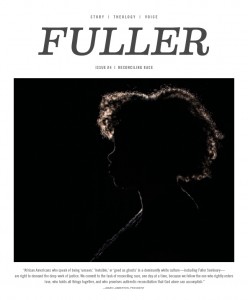
+ 100%/100% by Angelica Sotiriou-Rausch, acrylic on canvas, 8’ x 3.5’, 2008, angelicasotiriou.com. The title refers to 100% humanity and 100% divinity of Christ. The artist did a series of paintings using the horizon as a symbol of peace in Christ.
The Long March toward Reconciliation
Jeff Wright walked into my office recently, his eye caught by my wall of photos and notes and sketches and story ideas on race and reconciliation. He said, from his point of view as an African American trustee at Fuller, “I have more thoughts about this than either one of us has time for.” I offered him a chair. For over an hour, he spoke his burdened mind.
This issue of FULLER magazine is the most challenging work I’ve done since I came to the seminary. It is not meant to address race relations in America; it’s about reconciling race here—at Fuller and in the wider church we serve. Twenty years ago, in his book The Coming Race Wars, Bill Pannell warned of upheaval if ever again we saw desecration like the four little girls murdered at the 16th Street Baptist Church in Birmingham; yet, here we are again, with the murder of nine innocent churchgoers in Charleston. What hope can we have for change?
When I was young, addressing the unhealed wound between American blacks and whites was something I felt passionate about, convinced of the power of the gospel and my own puny will. I started by listening—to Martin Luther King Jr., Billie Holiday, Ralph Ellison, John Perkins, August Wilson, Maya Angelou, James Baldwin. I said, aloud and in my heart, “I see.” I didn’t, of course.
By middle age my longing for unity had grown, yet my understanding of racism had expanded from a binary one to one as diverse as the people to tell it. I was sometimes surprised by bitter vitriol from Christians I assumed would work toward healing. I offered friendship to brothers and sisters who needed more than surface reconciliation. As a million untold stories of offense widened the well of sorrow from pool to ocean, I felt paralyzed by my own undeserved privilege and inadequacy to love enough.
Now, at nearly six decades, I don’t have time to be paralyzed by fear. I resolve to love, ready or not: I know I risk offending where I mean to bless, aggravating pain in my clumsiness, exposing dark motives and ignorance, especially my own. No one is ready for reconciliation, but we must move toward it nevertheless. The fight I can fight for justice every day is not against the insidious evils of racism, but against its unseen roots in me. It is there, in my own murky heart, where the only real hope for transformation ever was. Finally, I see.
Years ago, when my white niece was a teenager, she caught a micro-expression of disapproval from her beloved grandmother upon meeting a black boyfriend. Deeply conflicted by that memory, she later posed an impossible dilemma: was my mother—servant of prayer, model of all things Christlike, beloved caretaker of family infants—was she prejudiced or was my niece crazy? “You are not crazy,” I said, carefully, and her shoulders dropped with unwelcomed relief and disappointment. I added: “I am prejudiced, too—though less than my mother was. And she was less prejudiced than her mother. So, we inherited their weaknesses, but they also made us stronger than they were. Each generation does that, in spite of their faults, by teaching us to follow the way of Jesus.”
The story of American racism is as deep as the generations that have tolerated it, so reconciling race is a march of a thousand miles. Every day offers steps toward justice: every act of kindness, every release of offense, every intent to prefer another, every informed act of empowerment can teach us to love our neighbors as ourselves. We may not see the promised land of reconciliation in this life, but as long as the way of Jesus marches toward it, we must, too.


